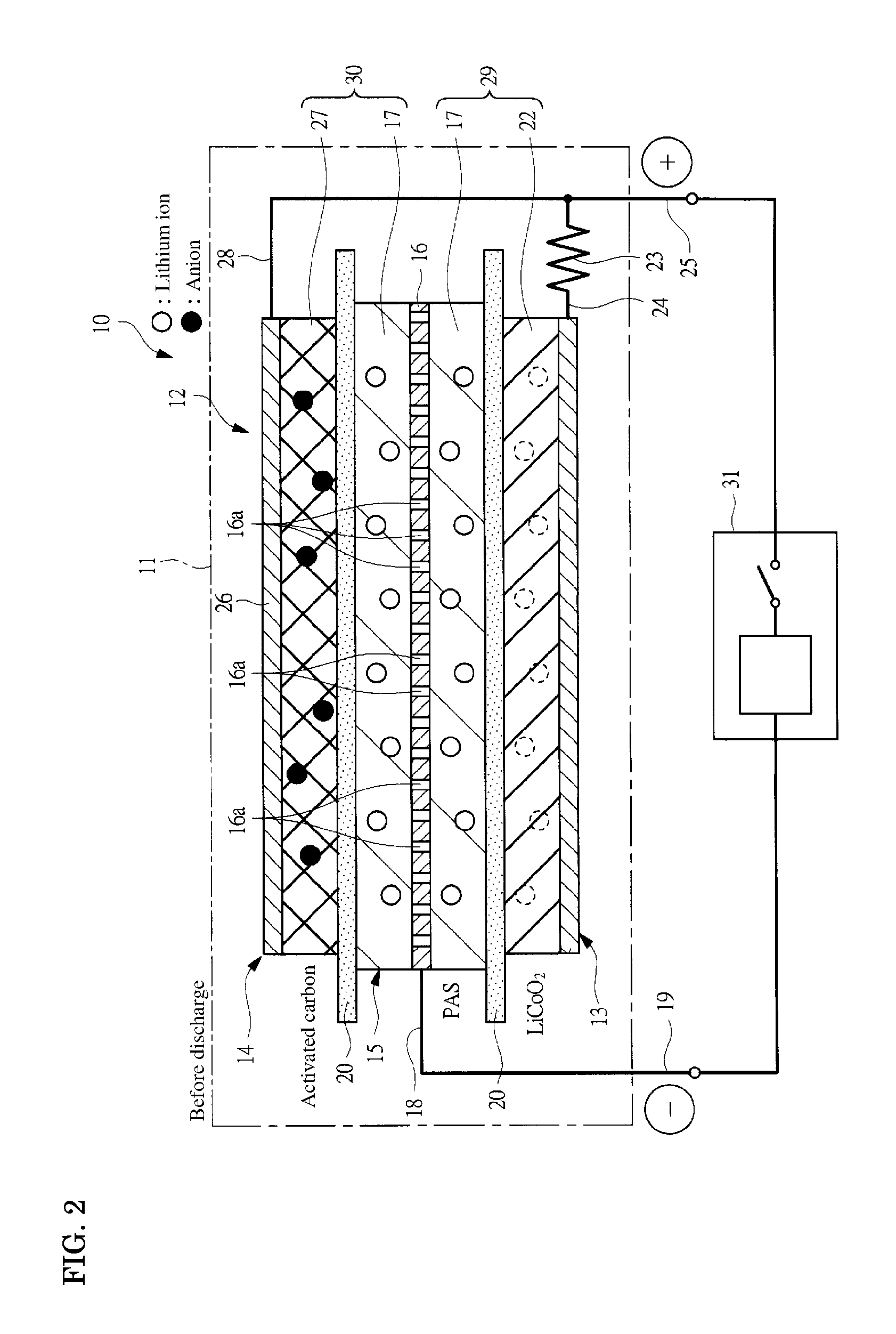Electric storage device
a technology of electric storage device and electric double layer capacitor, which is applied in the direction of cell components, sustainable manufacturing/processing, and final product manufacturing, etc., can solve the problems of low output, high capacity, and low capacity of lithium ion secondary batteries, and achieve the effect of increasing output, increasing capacity of electric storage devices, and high capacity
- Summary
- Abstract
- Description
- Claims
- Application Information
AI Technical Summary
Benefits of technology
Problems solved by technology
Method used
Image
Examples
example 1
Fabrication of Negative Electrode 1
[0101]A phenolic resin molded plate with a thickness of 0.5 mm was put into a Siliconit electric furnace and heat-treated under a nitrogen atmosphere at a rate of 50° C. / hour till temperature reached 500° C., and further heat-treated at the rate of 10° C. / hour till temperature reached 700° C., whereby a PAS plate was synthesized. The PAS plate thus synthesized was pulverized with a disc mill into PAS powders. The PAS powders had a H / C ratio of 0.17.
[0102]Then, 100 parts by weight of the above PAS powder and a solution prepared by dissolving 10 parts by weight of polyvinylidene fluoride powder in 80 parts by weight of N-methyl pyrrolidone were sufficiently mixed to prepare a slurry 1 for the negative electrode. The slurry 1 for the negative electrode was coated uniformly over both surfaces of a copper expanded metal (manufactured by Nippon Metal Industry Co., Ltd.) having a thickness of 32 μm (porosity of 50%) by a die coater. The slurry 1 for the n...
example 2
Fabrication of Cell 3
[0115]Four cells 3 were assembled in the same manner as in the Example 1, except that ten sheets of non-woven fabric made of polyethylene with a thickness of 35 μm, which were used as the separator, were arranged between the positive electrode 1 and the negative electrode 2. Specifically, ten separators were superimposed between the positive electrode 1 and the negative electrode 1, while one separator was arranged between the positive electrode 2 and the negative electrode 1. The amount of the metal lithium located in each cell 3 was equivalent to 380 mAh / g per negative-electrode active material weight.
Initial Evaluation of Cell 3
[0116]The thus assembled cells 3 were left for 30 days, and one cell of four cells 3 was disassembled. It was confirmed that no metal lithium remained. From this fact, it was considered that the amount of lithium ion equivalent to 380 mAh / g per negative-electrode active material weight was pre-doped.
Characteristic Evaluation of Cell 3
[...
example 3
Evaluation of Overdischarge Characteristic of Cell 1
[0121]The cell 1 was charged at a constant current of 100 mA till the cell voltage reached 4.0 V, and then the cell 1 was charged by applying a constant voltage of 4.0 V. This constant-current constant-voltage charging method was performed for 6 hours. Then, the cell was discharged at a constant current of 100 mA till the cell voltage reached 0 V. The cycle of the charging operation (100 mA charge) to 4.0 V and the discharging operation (100 mA discharge) to 0 V was repeated, and when the cycle was repeated 10 times, no trouble such as swelling of the cell was not observed.
PUM
| Property | Measurement | Unit |
|---|---|---|
| voltage | aaaaa | aaaaa |
| voltage | aaaaa | aaaaa |
| current | aaaaa | aaaaa |
Abstract
Description
Claims
Application Information
 Login to View More
Login to View More - R&D
- Intellectual Property
- Life Sciences
- Materials
- Tech Scout
- Unparalleled Data Quality
- Higher Quality Content
- 60% Fewer Hallucinations
Browse by: Latest US Patents, China's latest patents, Technical Efficacy Thesaurus, Application Domain, Technology Topic, Popular Technical Reports.
© 2025 PatSnap. All rights reserved.Legal|Privacy policy|Modern Slavery Act Transparency Statement|Sitemap|About US| Contact US: help@patsnap.com



